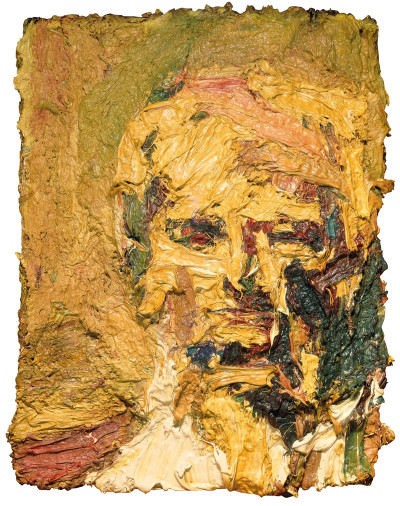Frank Helmut Auerbach (born 29 April 1931) is a German-born British painter. He has been a naturalised British citizen since 1947
Auerbach is a figurative painter, who focuses on portraits and city scenes in and around the area of London in which he lives, Camden Town.Although sometimes described as expressionistic, Auerbach is not an expressionist painter. His work is not concerned with finding a visual equivalent to an emotional or spiritual state that characterised the expressionist movement, rather it deals with the attempt to resolve the experience of being in the world in paint. In this the experience of the world is seen as essentially chaotic with the role of the artist being to impose an order upon that chaos and record that order in the painting.This ambition with the paintings results in Auerbach developing intense relationships with particular subjects, particularly the people he paints, but also the location of his cityscape subjects. Speaking on this in 2001 he stated: "If you pass something every day and it has a little character, it begins to intrigue you." This simple statement belies the intensity of the relationship that develops between Auerbach and his subjects, which results in an astonishing desire to produce an image the artist considers 'right'. This leads Auerbach to paint an image and then scrape it off the canvas at the end of each day, repeating this process time and again, not primarily to create a layering of images but because of a sense of dissatisfaction with the image leading him to try to paint it again.
Auerbach is a figurative painter, who focuses on portraits and city scenes in and around the area of London in which he lives, Camden Town.Although sometimes described as expressionistic, Auerbach is not an expressionist painter. His work is not concerned with finding a visual equivalent to an emotional or spiritual state that characterised the expressionist movement, rather it deals with the attempt to resolve the experience of being in the world in paint. In this the experience of the world is seen as essentially chaotic with the role of the artist being to impose an order upon that chaos and record that order in the painting.This ambition with the paintings results in Auerbach developing intense relationships with particular subjects, particularly the people he paints, but also the location of his cityscape subjects. Speaking on this in 2001 he stated: "If you pass something every day and it has a little character, it begins to intrigue you." This simple statement belies the intensity of the relationship that develops between Auerbach and his subjects, which results in an astonishing desire to produce an image the artist considers 'right'. This leads Auerbach to paint an image and then scrape it off the canvas at the end of each day, repeating this process time and again, not primarily to create a layering of images but because of a sense of dissatisfaction with the image leading him to try to paint it again.
This also indicates that the thick paint in Auerbach's work, which led to some of Auerbach's paintings in the 1950s being considered difficult to hang, partly due to their weight and according to some newspaper reports in case the paint fell off,[17] is not primarily the result of building up a lot of paint over time. It is in fact applied in a very short space of time, and may well be scraped off very soon after application.[15] This technique has not always been considered positively, with the Manchester Guardian newspaper commenting in 1956 that: "The technique is so fantastically obtrusive that it is some time before one penetrates to the intentions that should justify this grotesque method."
This intensity of approach and handling has also not always sat well with the art world that developed in Britain from the late 1980s onwards, with one critic at that time, Stuart Morgan, denouncing Auerbach for espousing 'conservatism as if it were a religion' on the basis that he applies paint without a sense of irony.
As well as painting street scenes close to his London home, Auerbach tends to paint a small number of people repeatedly, including Estella Olive West (indicated in painting titles as EOW), Juliet Yardley Mills (or JYM) and Auerbach's wife Julia Auerbach (née Wolstenholme).Again a similar obsession with specific subjects, and a desire to return to them to 'try again' is discernable in this use of the same models.
As well as painting street scenes close to his London home, Auerbach tends to paint a small number of people repeatedly, including Estella Olive West (indicated in painting titles as EOW), Juliet Yardley Mills (or JYM) and Auerbach's wife Julia Auerbach (née Wolstenholme).Again a similar obsession with specific subjects, and a desire to return to them to 'try again' is discernable in this use of the same models.
A strong emphasis in Auerbach's work is its relationship to the history of art. Showing at the National Gallery in London in 1994 he made direct reference to the gallery's collection of paintings by Rembrandt, Titian and Rubens. Unlike the National Gallery's 'Associate Artist Scheme', however, Auerbach's work after historic artists was not the result of a short residency at the National Gallery, it has a long history, and in this exhibition he showed paintings made after Titian's Bacchus and Ariadne, from the 1970s to Rubens's Samson and Delilah made in 1993.
Auerbach's personal history, and his painting style, are the basis for the character "Max Ferber" in W. G. Sebald's award-winning novel, The Emigrants (1992 in Germany, 1996 in Britain).Wikipedia
Auerbach's personal history, and his painting style, are the basis for the character "Max Ferber" in W. G. Sebald's award-winning novel, The Emigrants (1992 in Germany, 1996 in Britain).Wikipedia









No comments:
Post a Comment